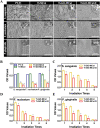Graphene oxide and mineralized collagen-functionalized dental implant abutment with effective soft tissue seal and romotely repeatable photodisinfection
- PMID: 35529047
- PMCID: PMC9071057
- DOI: 10.1093/rb/rbac024
Graphene oxide and mineralized collagen-functionalized dental implant abutment with effective soft tissue seal and romotely repeatable photodisinfection
Abstract
Grasping the boundary of antibacterial function may be better for the sealing of soft tissue around dental implant abutment. Inspired by 'overdone is worse than undone', we prepared a sandwich-structured dental implant coating on the percutaneous part using graphene oxide (GO) wrapped under mineralized collagen. Our unique coating structure ensured the high photothermal conversion capability and good photothermal stability of GO. The prepared coating not only achieved suitable inhibition on colonizing bacteria growth of Streptococcus sanguinis, Fusobacterium nucleatum and Porphyromonas gingivalis but also disrupted the wall/membrane permeability of free bacteria. Further enhancements on the antibacterial property were generally observed through the additional incorporation of dimethylaminododecyl methacrylate. Additionally, the coating with sandwich structure significantly enhanced the adhesion, cytoskeleton organization and proliferation of human gingival fibroblasts, which was effective to improve soft tissue sealing. Furthermore, cell viability was preserved when cells and bacteria were cultivated in the same environment by a coculture assay. This was attributed to the sandwich structure and mineralized collagen as the outmost layer, which would protect tissue cells from photothermal therapy and GO, as well as accelerate the recovery of cell activity. Overall, the coating design would provide a useful alternative method for dental implant abutment surface modification and functionalization.
Keywords: antibacterial; dental implant abutment; graphene oxide; mineralized collagen; soft tissue sealing.
© The Author(s) 2022. Published by Oxford University Press.
Figures










Similar articles
-
Evaluation of the sealing capability of implants to titanium and zirconia abutments against Porphyromonas gingivalis, Prevotella intermedia, and Fusobacterium nucleatum under different screw torque values.J Prosthet Dent. 2014 Sep;112(3):561-7. doi: 10.1016/j.prosdent.2013.11.010. Epub 2014 Mar 20. J Prosthet Dent. 2014. PMID: 24656409
-
Keratinocytes protect soft-tissue integration of dental implant materials against bacterial challenges in a 3D-tissue infection model.Acta Biomater. 2019 Sep 15;96:237-246. doi: 10.1016/j.actbio.2019.07.015. Epub 2019 Jul 11. Acta Biomater. 2019. PMID: 31302293
-
Dopamine self-polymerized along with hydroxyapatite onto the preactivated titanium percutaneous implants surface to promote human gingival fibroblast behavior and antimicrobial activity for biological sealing.J Biomater Appl. 2018 Mar;32(8):1071-1082. doi: 10.1177/0885328217749963. Epub 2018 Jan 4. J Biomater Appl. 2018. PMID: 29301451
-
Application of Graphene Oxide in Oral Surgery: A Systematic Review.Materials (Basel). 2023 Sep 20;16(18):6293. doi: 10.3390/ma16186293. Materials (Basel). 2023. PMID: 37763569 Free PMC article. Review.
-
Influence of Modified Titanium Abutment Surface on Peri-implant Soft Tissue Behavior: A Systematic Review of In Vitro Studies.Int J Oral Maxillofac Implants. 2020 May/Jun;35(3):503-519. doi: 10.11607/jomi.8110. Int J Oral Maxillofac Implants. 2020. PMID: 32406646
Cited by
-
Can Graphene Pave the Way to Successful Periodontal and Dental Prosthetic Treatments? A Narrative Review.Biomedicines. 2023 Aug 23;11(9):2354. doi: 10.3390/biomedicines11092354. Biomedicines. 2023. PMID: 37760795 Free PMC article. Review.
-
Surface modification strategies to reinforce the soft tissue seal at transmucosal region of dental implants.Bioact Mater. 2024 Sep 10;42:404-432. doi: 10.1016/j.bioactmat.2024.08.042. eCollection 2024 Dec. Bioact Mater. 2024. PMID: 39308548 Free PMC article. Review.
-
Bio-inspired nanocomposite coatings on orthodontic archwires with corrosion resistant and antibacterial properties.Front Bioeng Biotechnol. 2023 Oct 20;11:1272527. doi: 10.3389/fbioe.2023.1272527. eCollection 2023. Front Bioeng Biotechnol. 2023. PMID: 37929189 Free PMC article.
-
Biomaterials for neuroengineering: applications and challenges.Regen Biomater. 2025 Feb 21;12:rbae137. doi: 10.1093/rb/rbae137. eCollection 2025. Regen Biomater. 2025. PMID: 40007617 Free PMC article. Review.
-
Soft tissue integration around dental implants: A pressing priority.Biomaterials. 2026 Jan;324:123491. doi: 10.1016/j.biomaterials.2025.123491. Epub 2025 Jun 9. Biomaterials. 2026. PMID: 40505390 Review.
References
-
- Bonifacio MA, Cometa S, Dicarlo M, Baruzzi F, de Candia S, Gloria A, Giangregorio MM, Mattioli-Belmonte M, De Giglio E.. Gallium-modified chitosan/poly (acrylic acid) bilayer coatings for improved titanium implant performances. Carbohydr Polym 2017;166:348–57. - PubMed
-
- Hoyos-Nogués M, Buxadera-Palomero J, Ginebra MP, Manero JM, Gil F, Mas-Moruno C.. All-in-one trifunctional strategy: a cell adhesive, bacteriostatic and bactericidal coating for titanium implants. Colloids Surf B 2018;169:30–40. - PubMed
-
- Zhi Z, Su Y, Xi Y, Tian L, Xu M, Wang Q, Pandidan S, Padidan S, Li P, Huang W.. Dual-functional polyethylene glycol-b-polyhexanide surface coating with in vitro and in vivo antimicrobial and antifouling activities. ACS Appl Mater Interfaces 2017;9:10383–97. - PubMed
LinkOut - more resources
Full Text Sources
Molecular Biology Databases

